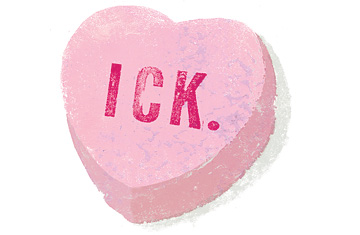
I’m sentimental about many things: the lumpy feel of a baby’s unused feet, the metallic smell of the air before the first snow, the last scene in It’s a Wonderful Life. But Valentine’s Day leaves me cold. It’s a holiday that has no idea of what it’s really celebrating. Or at least no idea of whom it celebrates: St. Valentine could be any of half a dozen Christian martyrs whom the early church recruited to clean up and bless pagan fertility festivals. Of the top candidates, the best known is a priest named Valentinus, who was beheaded by Emperor Claudius the Cruel on Feb. 14, A.D. 269. Upon slim evidence, whole layers of legend are stacked: that Valentinus performed secret weddings after Claudius banned marriage to prevent soldiers from deserting his armies; that he refused to deny Christ and so was thrown in prison, where he healed the jailer’s blind daughter; that he fell in love with her and left a note in the cracks of his cell the night before his execution, “From your Valentine.”
Now martyrdom is admirable, even preferable, in a saint, but it is terrible in a relationship in which generosity demands payment in guilt. And a celebration that once featured bachelors pulling women’s names out of an urn like a door prize and a belief that the first person you spotted on the morning of Feb. 14 would be your mate for life doesn’t say much for romance. (Some maids were taught that if they awoke and saw a blackbird, they would marry a clergyman; a bluebird meant a poor man; a robin meant a sailor.) Over the years, Valentine became the patron saint of engaged couples and happy marriages, but also of beekeepers and, of course, greeting-card manufacturers. Love comes with a sting, and at a price.
In the interests of domestic harmony, I should say that my wonderful husband has always handled the day’s customs with flair. Our daughters like it for the candy, which now comes in quantities rivaled only by Halloween, with Tootsie Rolls taped to the cards kids hand out. I have no problem with the holiday for 8-year-olds, now that it has shed its Darwinian savagery. Children are expected to bring a valentine for every classmate, unlike the days of our youth, when the teachers would collect the cards in a big red box and then call out names one by one, in a public accounting of exactly how many friends each child actually had.
On the other hand, the idea of 8-year-olds’ celebrating a holiday that shimmies into view wearing a negligee does seem odd. But consider the huge commercial stakes: “The tradition of sending and receiving classroom valentines,” observes American Greetings, which owns a $1.8 billion piece of the “social expression” industry, “is often a child’s first experience with greeting cards.” A billion cards are sent every year, second only to Christmastime, and 85% of them by women. For this we can thank Esther Howland, an entrepreneurial 1847 Mount Holyoke grad, whose father owned a stationery store and who came up with the idea of mass-producing valentines. The Mother of the Valentine never married but did get very rich, racking up annual sales equivalent to more than $2 million today.
For many of us, though, Valentine’s Day only pretends to celebrate what we like about love while actually undermining it. True romance comes unscheduled, unruly, “a madness most discreet,” quoth Romeo. Over time, as it ripens into devotion, still it improvises, a favor rendered, a sudden kiss, a private joke, flowers for no reason. Its expression is the very opposite of the fretful, “pre-order now, or be left with drugstore chocolates” connivances that the day promotes. For those who feel well loved, every day, of course, is Valentine’s. For the rest, no card can console.
That’s why the holiday lends itself so nicely to ridicule. Valentine’s Day has inspired its own insurgency, “Singles Awareness Day,” in which the unattached celebrate their solitude with a saucy “Happy SAD day.” Any holiday that triggers guerrilla opposition should give us pause. “Finding the right Valentine’s Day gift is probably the most difficult shopping experience in any man’s life,” warns AskMen.com which notes that unlike Christmas or birthday presents, these gifts reflect not only taste and affection “but your degree of commitment as well.” Experts argue over subtexts: Is giving lingerie a turn-on or just tacky? Restaurants sweeten the menu and hike the prices; Christian websites offer valentine messages from God. You can buy a heart-shaped potato on eBay. It comes in a red box.
There’s nothing wrong, of course, with delighting in love and honoring friendship and stopping in the bleak midwinter to tickle the people we love. But it’s also a good sign of psychosocial health if the day just saunters by and winks, and you feel no need to pay attention. The minute it feels like a duty, it has lost its purpose. “Love sought is good,” Shakespeare observed, “but given unsought is better.”
More Must-Reads from TIME
- How the Economy is Doing in the Swing States
- Democrats Believe This Might Be An Abortion Election
- Our Guide to Voting in the 2024 Election
- Mel Robbins Will Make You Do It
- Why Vinegar Is So Good for You
- You Don’t Have to Dread the End of Daylight Saving
- The 20 Best Halloween TV Episodes of All Time
- Meet TIME's Newest Class of Next Generation Leaders
Contact us at letters@time.com